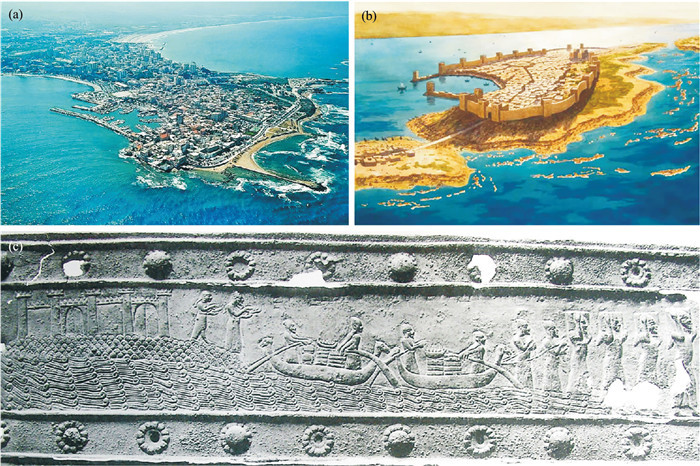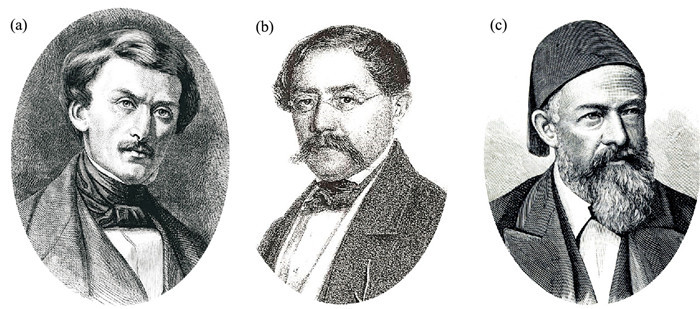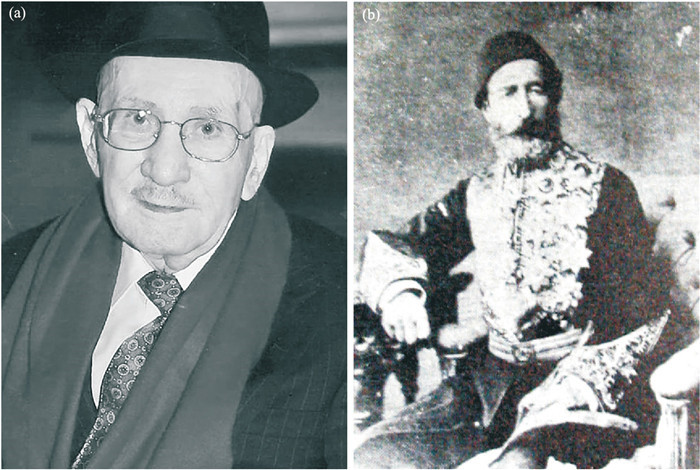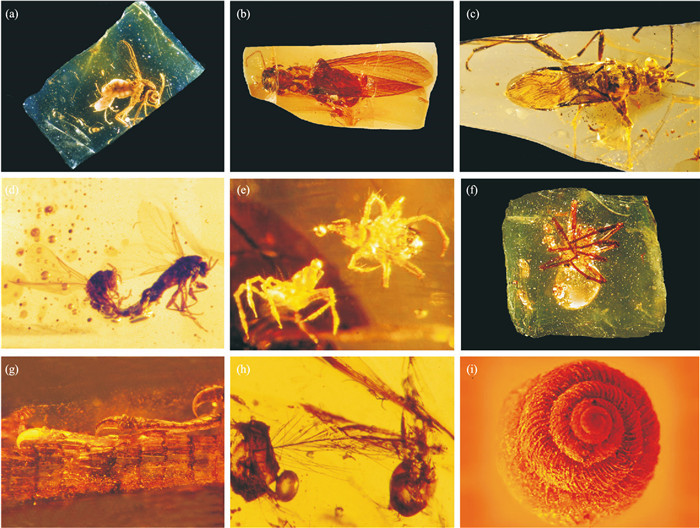
| Citation: | Maksoud Sibelle, Azar Dany. Lebanese Amber: A Fantastic Journey into the Time of Dinosaurs[J]. Journal of Gems & Gemmology, 2023, 25(4): 136-145. DOI: 10.15964/j.cnki.027jgg.2023.04.012 |
Amber, a fossilized plant resin, has been preserved throughout geological time (Langenheim, 1969). Its unique chemical compositions allow for the exceptional preservation of biological inclusions in their three-dimensional, pristine, and minute details (Langenheim, 2003; Poinar, 1992). Amber occurs all over the world and its age ranges between a few millions and 320 million years (Mid Carboniferous) (Sargent Bray & Anderson, 2009).
Lebanon is well known for its numerous Mesozoic amber deposits (Azar, 1997, 2012;Azar et al., 2010; Maksoud & Azar, 2020; Maksoud et al., 2022). Leban on with its small territories and its multiple amber outcrops is relatively the richest country with amber. Most of the amber outcrops in Lebanon are Early Cretaceous [early Barremian (Maksoud et al., 2017)] in age (ca. 450 outcrops found to date), others are Late Jurassic (Kimmeridgian) [19 outcrops (Nohra et al., 2013) (Fig. 1)]. It is however noteworthy that a single rounded amber bead (from early Barremian origin) was found redeposited in an Albian marine deposit in Rwaysat Saoufar [Caza (District) Aley, Mouhafazet (Governorate) Jabal Loubnan, Central Lebanon].Anecdotally, another millimetric amber bead was found interspersed within the bone accumulation of a late middle Cenomanian fossil bird from Nammoura [Caza (District) Kesserouane, Mouhafazet (Governorate) Jabal Loubnan, Central Lebanon] (Dalla Vecchia & Chiappe, 2002). Approximately 10% of the land in Lebanon contains amber. Traditional Lebanese songs describe rightly Lebanon as the “mountains of amber”. Lebanon in several verses of the Bible was described as “land of the milk and honey”. Given the aforementioned reasons, we hereby proclaim Lebanon as the land of amber. Astonishingly, despite the numerous Lower Cretaceous amber deposits found throughout Lebanon, only 30 of these, all of which belong to the Early Cretaceous period, have been discovered to contain biological inclusions — 29 of which have already been published, while the discovery of a new outcrop in the Rashaya District on the 17th of April 2023 will soon be published (Fig. 2).
For a considerable amount of time, prior to recent discoveries (primarily in the Dolomite mountains of Italy, as reported by Schmidt et al., 2012), Lower Cretaceous amber in Lebanon was regarded as the oldest known amber to contain biological inclusions.Today, even if it no longer retains the record of containing the oldest amberiferous biological inclusions, along with Syrian (Choufani et al., 2015), and Jordanian (Kaddumi, 2005) ambers, both of which are considered as coeval with Lebanese lower Barremian amber, it is still among the most important for the study of arthropod evolution, as the period of its formation is contemporaneous with the appearance of flowering plants (angiosperms) and the associated newly evolved ecosystems. Moreover, it documents the initial diversification of the modern entomofauna and the disappearance of some archaic insect groups (Azar, 1997, 2000, 2007, 2012; Azar &Nel, 1998; Poinar & Milki, 2001; Azar et al., 2010).
The Phoenicians [an ancient civilization (with period of greatest prominence approximately 1550 to 300 BC) that ruled the Mediterranean before the Greeks and Romans and originated in the Levant especially Lebanon, in the west of the Fertile Crescent] were most likely the first tradesmen of amber in the Mediterranean (McDonald, 1940). It is believed that between the sixteenth and fourth centuries BC (but especially between the eighth and fourth centuries BC), the Phoenicians pioneered the Amber Route (Fig. 3), a maritime trade route from the Mediterranean to the shores of northern Europe, specifically the Baltic area. This route allowed for the exchange of golden fossil resin for bronze.
According to some authors based on recent archeological discoveries, amber was collected in Phoenicia (today Lebanon, the Syrian coast and northern Israel) and marketed in the Middle East by Phoenicians until the Baltic amber, which is of better gemological quality, became accessible (Williamson, 1932; Nissenbaum, 1975) (Fig. 4).
The mythical foundation of the ancient metro-polis of Tyre (southern Lebanon) is correlated with amber, where it is believed that this biblical city was founded on two ambrosian rocks (Fig. 5). According to the legend, two wandering ambrosian rocks floated over the sea; between them was a burning olive tree with an eagle perched on top of it. A snake was entwined around the tree; both eagle and snake lived in harmony. Melqart (also Melkarth or Melicarthus) [son of Baal (or El, Ruler of the Universe), tutelary god of the city-state of Tyre, king of the underworld, protector of the Universe] ordered the native population to build a ship and follow after the wandering rocks (Fig. 6).The god’s oracle was to sacrifice the eagle and pour its blood on the ambrosial rocks so that these later would stop wandering, indicating the place for the foundation of the city of Tyre. The myth is symbolically described on several of the coin types of the city, minted under the reigns of several Roman Emperors like Elagaba-lus (218~222 AD) (Fig. 6b, 6f, 6g), Gordian Ⅲ (238~244 AD) (Fig. 6c, 6h, 6i), Trebonianus Gallus (251~253 AD) (Fig. 6d, 6j) and Valerian I (253~290 AD) among others (Fig 6e, 6k).
The word “Lebanon” derives from “Louban” which has two meanings: white, in relation to the Lebanese snowed mountains; and incense, maybe in relation to cedars’ resin used by Pharaonic Egyptians for mummification, or perhaps simply to amber. It is likely that the Slavic word yantar, which is one of the words that is used for amber, could be of Phoenician origin (Szwedo, personal communication, 2022 November 5th).
In modern time, although the presence of amber in Lebanon has been documented several times since the beginning of the nineteenth century (Desmarest, 1816; Kastner, 1831; Botta, 1831; Brocchi, 1843; Russegger, 1843; Ritter, 1854; Fraas, 1876, 1878; John, 1878; Cuinet, 1896) and the twentieth century (Zumoffen, 1926; Dubertret, 1950, 1951, 1955), it is only late in the 1960s that fossil insects were recorded in this material (Schlee & Dietrich, 1970; Dietrich, 1976; Hennig, 1970). As a matter of fact, people in Lebanon during the eighteenth and nineteenth centuries were not very interested in the amber by itself (because of its bad gemological quality), but in the more or less abundant coal associated with amber layers, as a source of energy. The amber was cited by the above nineteenth century authors occasionally while describing the coal or lignite extractions in the mines. The first geological maps of Lebanon made by Botta (Fig. 7a), then by Russegger (Fig. 7b), had an aim to locate the lignite and iron mines in order for them to be exploited for energy and industry.
In 1962, Aftim Acra (Fig. 8a), while leading a fossil hunting expedition in the mountains in Daher-El-Baydar (Central Lebanon) and accompanied by his son Fadi and Raif Milki, found a piece of amber. From then till the 1970s they found several amber outcrops including the well-known one of Bkassine (Jouar Ess-Souss) in Jezzine area, which was discovered independently and at the same time by a German expedition organized between 1968-1969. The German expedition was carried out after M. Warth gave Willi Hennig (in 1967) some samples of amber from Bkassine (Southern Lebanon) kept in the Ludwigsburg collection in Stuttgart Museum. These samples were the remains of the collection of Oscar Fraas (1824-1897) (Fig. 7c), a German geologist who was tasked by Rustem Pasha (Rustem Mariani 1810-1885) (Fig. 8b), the Italian governor of Mount Lebanon (1873-1883), to study the geology in order to find coal mines. From 1994 till the present day, a total of approximately 450 amber deposits have been discovered, spanning from the Late Jurassic to the Cenomanian period.
Amber from the Late Jurassic in Lebanon (19 sites, all located in the northern part of Mount Lebanon (Azar et al., 2010; Nohra et al., 2013) is found in volcanolateritic deposits (volcanic Kimmeridgian, symbolized as βJ6 in existing geological maps of Lebanon). The amber is found in lens of lignite mixed with laterites and pyrite that occupy pits in volcano-basaltic complex soil (Fig. 9a, 9b).
Amber from the Lower Cretaceous (Fig. 10a, 10b) in Lebanon appears in silt sediments in the form of dark shales with lignite and fossil plant debris in mainly three intervals of the sandstone dubbed “Grès du Liban” Formation. Their deposits are interpreted as corresponding to siliciclastic coastland estuarine palaeoenvironments based on the occurrence of bioturbation, echinids and bivalves in the transgressive marine layers and that of amber and lignite in the regressive layers.
The entomofauna association of the amber inclusions indicates a dense and dark amber producing forest with warm tropical climate, which is also corroborated by palynological data (Azar et al., 2011).
For a long time, the age of Lower Cretaceous Lebanese amber remained subject to debate and imprecision. Various authors dated the outcrops as Neocomian-Aptian (Zumoffen, 1926), Neocomian-Early Aptian (Dubertret & Vautrin, 1937), or Valanginian-Hauterivian in age (Schlee & Die-trich, 1970), encompassing a wide range spanning the entirety of the Early Cretaceous interval, with the exception of the Albian and potentially the late Aptian. In light of recent, thorough stratigraphic research, it has been determined that the Lower Cretaceous amber in Lebanon can be attributed to the early Barremian age (Granier et al., 2016; Maksoud et al., 2017; Maksoud et al., 2022).
The most fascinating aspects of the Lebanese amber are the abundance and the outstan-ding preservation of the biological inclusions. In addition, the Lebanese amber holds significant importance among scientists, as it hails from the Lower Cretaceous era—a time when dinosaurs roamed the earth and flowering plants (Angiospermae) made their debut, marking a pivotal moment in plant evolution as angiosperms make up approximately 80% of all the known green plants now living. While the relationship between terrestrial arthropods (especially insects) and plants is so keen, it is logical that if we want to understand the origin of all recent and modern ecosystems, we have to go back to the epoch of their starting point, i.e., the Lower Cretaceous. Moreover, no intense terrestrial fossil records have been corresponding to this era except for the Lebanese amber, which increase significantly the uniqueness and exceptionality of this material. Inclusions can be found in one in every 25 to 30 pieces of Lebanese amber. This amber contains mainly arthropods and rarely includes vertebrate remains (Fig. 11). Among arthropods, Hexapoda are largely dominant and most of the orders (23 to date) are represented. To date circa 265 taxa have been described and named from Lebanese amber, whereas other inclusions are still waiting their identification.
A single piece of amber can contain one or several inclusions. Some of those that were found alone may provide important indirect hints of the presence of other organisms, or reflect a specific habitat or palaeogeography. Regarding the specimens where several inclusions (or syninclusions) are found together, some of them are present only in a random manner, but a considerable number of them are assembled for an ecological behaviour mating or parasitism, etc.
Some inclusions can provide indirect evidence of specific habitats, or palaeoclimate. For example, chironomids (very common and diversified Diptera in the Lebanese amber), limoniids, tipulids and psychodid flies, caddisflies (Trichoptera) provide evidence of aquatic or very humid habitats. In general, most of the Lebanese amber inclusions reflect a hot, dense and humid forest environment. The information given by the whole inclusions corroborate the data set by the palynology: the palaeoenvironment of the amber deposits corresponds to a tropical dense, warm and humid forest with an intense complex fluvial system, all occurring close to the sea (Dejax et al., 1996, 1997) (Fig. 12). In addition, most of the fauna entombed in the Lebanese amber represent organisms living on the lower to mid part of trees. This could be explained by the fact that this type of fauna has more chance to be trapped, since normally all the resin drops falling down from the tree pass inevitably and more frequently by this area. The study of the different inclusions allowed a hypothesized reconstruction of the ancient terrestrial ecosystem (Fig. 12).
For countless centuries, amber has captivated the minds of many and will undoubtedly continue to do so. It constitutes a wonderful “natural time capsule” as termed by Ross(1998, 2010), and an original material that not only preserves superb biological inclusions in their pristine three-dimensional details, but also aspects of their life mode and ecology. Life forms preserved in amber increases significantly our knowledge of palaeobiodiversity, palaeoenvironment, and palaeoecology, and gives the amber its attribute of an exceptional “window to the past” given by Grimaldi (2003).
Lebanese amber contains many extinct families (some of them are known only from Lebanon) and the records of the oldest representatives of many modern families of terrestrial arthropods. In most cases, Lebanese inclusions constitute the “missing links” between the old fauna and the modern one. The study of the Lebanese amber inclusions is to date the only one that gives a clue in determining the North-East Gondwanan biodiversity and environment of the extremely significant Lower Cretaceous period. Recent findings of diverse and plentiful fossiliferous amber outcrops in Lebanon provide a promising opportunity to significantly enhance our understanding of the past. Lebanon that holds 10% of its land with potential amber outcrops, was described several times as the land of milk and honey, we herein baptized it also as the country or land of amber.
Endeavors are currently underway to classify the precious natural resource of amber as a part of the World Heritage list. The different Lebanese outcrops are not yet officially protected against vandalism. The loss or looting of these sites would undoubtedly constitute a grave blow to both human history and scientific understanding.
We thank two anonymous reviewers for their valuable comments on an earlier version of this work. We thank Prof.Yan Li and Mr. Qi Liu for inviting us to this contribution. This paper is a contribution of the activity of the laboratory “Advanced Micropalaeontology, Biodiversity and Evolution Researches” (AMBER) led by DA at the Lebanese University, and to the activity of the “Lebanese Palaeontological and Evolutive Association”.
| [1] |
500 Questions. (2023). 500 Questions about God & Christianity. 500 Questions. https://500questions.wordpress.com/2013/02/24/43-did-the-bible-accurately-predict-the-future-of-tyre-ezekiel-26/.
|
| [2] |
Austria-Forum. (2011). Ägyptische Studenten in der Berg-und Hüttenmä nnische Lehranstalt in Vordernberg, Steiermark. https://austria-forum.org/af/Wissenssammlungen/Essays/Geographie/%C3%84gyptische_Studenten_in_der_Lehranstalt_in_Vordernberg.
|
| [3] |
Ashurbanipal Library Project. (2013). Excavations begin. http://oracc.iaas.upenn.edu/asbp/archaeologyofthelibrary/excavations/index.html.
|
| [4] |
Azar D. (1997). A new method for extracting vegetal and insect fossils from the Lebanese amber. Palaeontology, 40 (4): 1 027-1 029.
|
| [5] |
Azar, D. (2000). Les ambres mésozoÏques du Liban. Unpublished PhD thesis, Université Paris XI, Orsay, France: 164.
|
| [6] |
Azar, D. (2007). Preservation and accumulation of biological inclusions in Lebanese amber and their significance. Comptes Rendus Palevol, 6 (1-2): 151-156. doi: 10.1016/j.crpv.2006.10.004
|
| [7] |
Azar, D. (2012). Lebanese amber: A "Guinness Book of Records". Annales Universitatis Paedagogicae Cracoviensis, Folia, 111: 44-60.
|
| [8] |
Azar, D., Dejax, J., Masure, E. (2011). Palynological analysis of amber-bearing clay from the Lower Cretaceous of Central Lebanon. Acta Geologica Sinica (English Edition), 85 (4): 942-949. doi: 10.1111/j.1755-6724.2011.00497.x
|
| [9] |
Azar D., Gèze R., Acra F. (2010). Chapter 14: Lebanese amber. In: Penney D. (ed.), Biodiversity of Fossils in Amber from the Major World Deposits. Siri Scientific Press, UK: 271-298.
|
| [10] |
Azar, D., Nel, A. (1998). Lebanese Lower Cretaceous amber. Meganeura, 2: 18-20.
|
| [11] |
Botta, P.E. (1831). Sur la structure géognostique du Liban et de l'Anti-Liban. Bulletin de la Société Géologique de France, 10: 234-239.
|
| [12] |
Brocchi, G.B. (1843). Giornale delle osservazioni fatte ne' viaggi in Egitto nella Siria e nella Nubia. Bassano: 774.
|
| [13] |
Choufani, J., El-Halabi, W., Azar, D., et al. (2015). First fossil insect from Lower Cretaceous Lebanese amber in Syria (Diptera: Ceratopogonidae). Cretaceous Research, 54: 106-116. doi: 10.1016/j.cretres.2014.12.006
|
| [14] |
Cuinet, V. (1896). Syrie, Liban et Palestine, géographie administrative, statistique descriptive et raisonnée. Leroux, Paris: 244.
|
| [15] |
Dalla Vecchia, F.M., Chiappe, L.M. (2002). First avian skeleton from the Mesozoic Gondwana. Journal of Vertebrate Paleontology, 22 (4): 856-860.
|
| [16] |
Dejax, J., Masure, E., Azar, D. (1996). Analyse palynologique d'un échantillon de sédiment du Crétacé inférieur du Liban. Strata, 1: 66-67.
|
| [17] |
Dejax, J., Masure, E., Azar, D. (1997). Analyse palynologique de deux échantillons de sédimentdu Crétacé inférieur du Liban. XVème Symposium de l'Association des Palynologues de Langue Française (Lyon, 1-3 Septembre 1997): 20-21.
|
| [18] |
Desmarest, N. (1816). Encyclopédie méthodique, ou par ordre de matières: par une société de gens de lettres, de savants et d'ar-tistes. Géographie Physique. Tome quatrième [part 2]. H. Agasse, Paris: 401-767.
|
| [19] |
Dietrich, H.G. (1976). Zur Entstehung und Erhaltung von Bernstein-Lagerstätten 2: Bernsteinambers Lagerstätten im Libanon. Neues Jahrbuch für Geologie und Paläontologie, Abhandlungen, 152: 222-279.
|
| [20] |
Dubertret, L. (1950). Carte géologique au 1∶50 000; Feuille de Djezzîne. République Libanaise, Ministère des travaux publics, Beyrouth.
|
| [21] |
Dubertret, L. (1951). Carte géologique au 1∶50 000; Feuille de Beyrouth. République Libanaise, Ministère des travaux publics, Beyrouth.
|
| [22] |
Dubertret, L. (1955). Carte géologique du Liban au 1∶200 000. République Libanaise, Ministère des travaux publics, Beyrouth.
|
| [23] |
Dubertret, L., Vautrin, H. (1937). Révision de la stratigraphie du Crétacé du Liban. In: Dubertret, L. (Ed.), Contributions à l'étude géologique de la côte libano-syrienne. Haut-Commissariat de la République Française en Syrie et au Liban, Notes et Mémoires (Section d'études Géologiques), 2 (1): 43-73.
|
| [24] |
Evidence-For-The-Bible. (n. d.). Archeological evidence for Tyre - A city that's impossible to conquer. Evidence-For-The-Bible. https://evidence-for-the-bible.com/archeological-evidence-for-the-bible/archeological-evidence-for-tyre-a-city-thats-impossible-to-conquer.
|
| [25] |
Fraas, O. (1876). Drei Monate am Libanon. Levy & Müller, Stuttgart: iv, 108.
|
| [26] |
Fraas, O. (1878). Geologisches aus dem Libanon. Jahreshefte des Vereins für vaterländische Naturkunde in Württemberg, 34: 257-391.
|
| [27] |
Granier, B., Toland, C., Gèze, R., et al. (2016). Some steps toward a new story for the Jurassic—Cretaceous transition in Mount Lebanon. Carnets de Géologie [Notebooks on Geology], 16 (8): 247-269.
|
| [28] |
Grimaldi, D.A. (2003). Amber: Window to the past. H.N. Abrams, New York: 216.
|
| [29] |
John, K. (1876). Bernstein und Schraufit aus dem Libanon. Verhandlungen der Kaiserlich-Königlichen Geologischen Reichsanstalt, Wien, 11: 255-257.
|
| [30] |
Kaddumi, H.F. (2005). Amber of Jordan: The oldest prehistoric insects in fossilized resin. Published by the author, Amman, Jordan. Eternal River Museum of Natural History: 168.
|
| [31] |
Kastner, K.W.G. (1831). Archiv für die gesammte Naturlehre. XXI. Band. J.A. Stein, Nürnburg: xvi, 472.
|
| [32] |
Langenheim, J.H. (1969). Amber: A botanical inquiry. Science, 163 (3872): 1 157-1 169. doi: 10.1126/science.163.3872.1157
|
| [33] |
Langenheim, J.H. (2003). Plant resins: Chemistry, evolution, ecology, and ethnobotany. Timber Press Inc., Portland: 586.
|
| [34] |
Maksoud S., Azar, D. (2020). Lebanese amber: Latest updates. Palaeoentomology, 3 (2): 125-155. doi: 10.11646/palaeoentomology.3.2.2
|
| [35] |
Maksoud, S., Azar, D., Granier, B., et al. (2017). New data on the age of the Lower Cretaceous amber outcrops of Lebanon. Palaeoworld, 26 (2): 331-338. doi: 10.1016/j.palwor.2016.03.003
|
| [36] |
Maksoud, S., Granier, B.R.C., Azar, D. (2022). Palaeoentomological (fossil insects) outcrops in Lebanon. Carnets de Géologie [Notebooks on Geology], 22 (16): 699-743. doi: 10.2110/carnets.2022.2216
|
| [37] |
McDonald, L.S. (1940). Jewels and gems. T.Y. Croswell Company, New York: 288.
|
| [38] |
Nissenbaum, A. (1975). Lower Cretaceous amber from Israel. Naturwissenschaften, 62 (7): 341-342. doi: 10.1007/BF00608894
|
| [39] |
Nohra, Y., Azar, D., Gèze, R., et al. (2013). New Jurassic outcrops from Lebanon. Terrestrial Arthropod Reviews, 6: 27-51. doi: 10.1163/18749836-06021056
|
| [40] |
Nsf2003. (n. d.). Top view of water close to beach Tyre city Lebanon. Freepik. https://www.freepik.com/premium-photo/top-view-water-close-beach-tyre-city-lebanon_4272667.htm.
|
| [41] |
Poinar, G.O. Jr. (1992). Life in amber. Standford University Press, Standford: 368.
|
| [42] |
Poinar, G.O., Jr., Milki, R. (2001). Lebanese amber: The oldest insect ecosystem in fossilized resin. Oregon State University Press, Corvallis: 96.
|
| [43] |
Ritter, C. (1854). Die Erdkunde von Asien. Band VIII. Zweite Abtheilung. Dritter Abschnitt. Die Sinai-Halbinsel, Palästina und Syrien. G. Reimer, Berlin: xiv, 995.
|
| [44] |
Ross, A.J. (1998). Amber: The natural time capsule. Natural History Museum, London: 73.
|
| [45] |
Ross, A.J. (2010). Amber: The natural time capsule. Natural History Museum, Earth Science Publications, London: 112.
|
| [46] |
Russegger, J. (1843). Reisen in Europa, Asien und Afrika besonderer Rücksicht auf die naturwissenschaftlichen Verhältnisse der betreffenden Länder, unternommen in den Jahren 1835 bis 1841. Erster Band. Zweiter Theil. E. Schweizerbart, Stuttgart: 471-1 102.
|
| [47] |
Sargent Bray, P., Anderson K.B. (2009). Identification of carboniferous (320 million years old) class Ic amber. Science, 326 (5 949): 132-134.
|
| [48] |
Schlee, D., Dietrich, H.G. (1970). Insectenfuhrender Bernstein aus der Unterkreide des Libanon. Neues Jahrbuch für Geologie und Paläontologie Monatshefte, 1970: 40-50.
|
| [49] |
Schmidt, A.R., Jancke, S., Lindquist, E.E., et al. (2012). Arthropods in amber from the Triassic period. Proceedings of the National Academy of Sciences of the United States of America, 109 (37): 14 796-14 801.
|
| [50] |
Wikimedia Commons. (n. d.). File: Oscar Fraas. https://commons.m.wikimedia.org/wiki/File:Oscar_Fraas.jpg.
|
| [51] |
Wikipedia. (2022b, October 6). Rüstem Mariani. https://en.m.wikipedia.org/wiki/R%C3%BCstem_Mariani.
|
| [52] |
Williamson, G.C. (1932). The book of amber. Ernst Benn Ltd. (Ed.), London: 268.
|
| [53] |
Zumoffen, G. (1926). Géologie du Liban. Carte géologique au 200.000ième. Barrière, Paris: 165.
|
| [1] | WANG Haotian, HUANG Huimin, YANG Lingyue, GU Yilu, YANG Mingxing, HONG Hanlie, WANG Chaowen. Quantified Analysis of Colour and Distribution of Colouring Impurity Minerals of Nanhong Agate from Baoshan, Yunnan Province[J]. Journal of Gems & Gemmology, 2025, 27(1): 1-12. DOI: 10.15964/j.cnki.027jgg.2025.01.001 |
| [2] | OU Yannan, LIU Jinsong, XU Fengshun, ZHANG Qian. Mechanism of Thermochromism of Cassiterite from Yunnan Province, China[J]. Journal of Gems & Gemmology, 2024, 26(4): 22-28. DOI: 10.15964/j.cnki.027jgg.2024.04.003 |
| [3] | LIU Yungui, ZHENG Jinyu, YAO Chunmao, CHEN Tao. Gemmological Characteristic of Fracture in Tianhuang[J]. Journal of Gems & Gemmology, 2022, 24(2): 31-36. DOI: 10.15964/j.cnki.027jgg.2022.02.004 |
| [4] | LIN Qingchun, ZHANG Zhiqing, Andy Hsitien Shen. Amber and Its Imitation in Tengchong Market, Yunnan Province[J]. Journal of Gems & Gemmology, 2018, 20(3): 28-38. DOI: 10.15964/j.cnki.027jgg.2018.03.004 |
| [5] | LI Zhixiang, YANG Jiong, QIU Zhili, LI Liufen, LIU Guiju. A Study on Sustainable Development of Jewelry Industry in Yunnan Province[J]. Journal of Gems & Gemmology, 2016, 18(1): 49-58. |
| [6] | DU Shanshan, YIN Ke, HAN Wen, LIU Deng, YIN Yin. Mineralogical Characteristics of“Jinsiyu”(Quartz)[J]. Journal of Gems & Gemmology, 2014, 16(4): 49-53. |
| [7] | YE Dong, LIU Xue-liang. Study on Gemmological Characteristics of Rubies from Yuanjiang, Yunnan Province[J]. Journal of Gems & Gemmology, 2006, 8(3): 21-24. |
| [8] | LIANG Ting, XIE Xing. Gemmological Characteristics of Hemimorphite from Yunnan Province[J]. Journal of Gems & Gemmology, 2003, 5(4): 34-36. |
| [9] | Liang Ting. Study on Colouration Mechanism of Emerald from Yunnan Province[J]. Journal of Gems & Gemmology, 2001, 3(4): 21-24. |
| [10] | Li Qiang. Gemmological Characters of Malipo Emerald from Yunnan Province[J]. Journal of Gems & Gemmology, 2001, 3(2): 11-14. |





